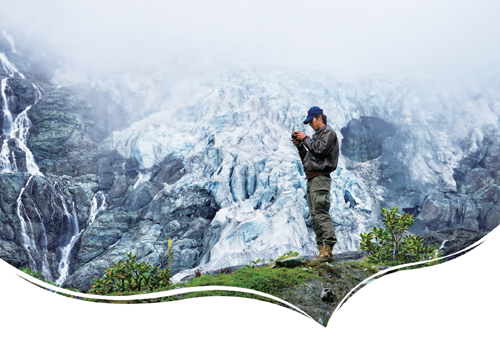New frontier of youth travel

Wang Zihao on a scientific exploration journey. CHINA DAILY
Young Chinese travelers are redefining adventure by moving beyond traditional tourism to seek unique experiences.
Under the night sky, a group of young people gathered, singing and dancing to rock music. While this might sound like a scene from a music festival, it was Zhang Chongling's experience at the base camp of Mount Qomolangma, also known as Mount Everest, at an altitude of 5,200 meters.
The base camp, according to Zhang, is open from March to October each year and offers a relatively accessible way to admire the majesty of the world's highest peak.
In October 2023, Zhang and her friends took an eco-friendly bus up the mountain and arrived just before the camp closed for the season. Around 9 pm, while resting in her tent, Zhang heard music and realized a celebration was underway.
Layering up in warm clothes, she stepped outside and found a group of young people spontaneously gathering in the base camp's square under the starry sky. They waved Chinese national flags and danced energetically to rock music, even though some of them had to breathe from oxygen tanks.
"People there ranged from their teens to their 40s," Zhang recalled. "Everyone was warm and welcoming, and no one asked about your personal life — you could just be yourself."
The accommodations at the base camp were basic, consisting of large tents with poor sound insulation. After the celebration, Zhang suffered from altitude sickness and had to rent a medical oxygen tank locally.
Despite this, as she watched the vibrant young people beneath the clearly visible Milky Way, the 27-year-old reflected, "I'll never be younger than I was at that moment."
Lesser-known gems
Like Zhang, many young people are moving away from traditional tourist spots and crowded destinations to explore lesser-known locations and unique experiences.
Recently, county towns, often described as the "capillaries" of China's geography, have become increasingly popular among these adventurous travelers.
Data from China's Ministry of Culture and Tourism reveals that the coverage of national A-level tourist attractions in counties has risen from 73 percent in 2012 to 93 percent in 2023.
Additionally, the Chinese lifestyle-sharing platform Xiaohongshu now features over 480,000 posts discussing "county travel".
One such content creator is Wang Yanling, 34, who travels with her husband, Wang Yanfei, and their dog, Taozi.
In 2022, Wang Yanling began documenting their adventures on social media, and by 2023, she noticed that many of her favorite "hidden gems" were small counties. This realization inspired her to launch a project on Xiaohongshu called "Explore 100 Hidden County Towns".
Wang Yanling recalls their first county visit to Wuyi in East China's Zhejiang province, discovered by chance during a drive.
This unexpected journey brought her great joy, especially when she found a remote, mountainside ancient village in this lesser-known town, a place previously documented by Chinese architect and architectural historian Liang Sicheng (1901-1972) in A History of Chinese Architecture.
"It was raining when we arrived, and the entire village seemed like a traditional Chinese ink painting," she said.
Based in Hangzhou, Zhejiang, Wang Yanling and her husband have extended their travels from nearby regions like Jiangsu and Anhui to other parts of China, including Shanxi, Guangdong, Jiangxi, and Shandong provinces.
Due to limited public transportation in some towns and their need to travel with a pet, the couple usually drives themselves.
They have found that many county towns are very welcoming to pets. "That made me realize that 'pet friendliness' is more of a big city concept. In smaller towns, people and animals coexist more naturally without strict boundaries," said Wang Yanling.
As their travels expanded, they discovered that each town had its own distinct charm. Some are known for their breathtaking landscapes, others for exceptional cuisine, and some for their cultural and historical significance.
"Even within the same city, each county has a unique vibe," said Wang Yanfei. "To me, travel is about experiencing different cultures and seeing new landscapes. Your worldview is shaped by what you've seen in the world."
Journey redefined
In addition to seeking new destinations, young travelers are also shifting away from group tours organized by traditional travel agencies, opting instead for personalized experiences with like-minded peers.
Wang Min, 25, a master's student at Shanghai University, often travels alone because her friends live in different places and are busy with their jobs. However, after joining several youth-focused travel groups, Wang connected with many people who shared similar interests.
"You can find many of these groups on Xiaohongshu, ranging from those organized by travel agencies to user-created ones," she explained, adding that these groups cater to various interests, from general travel to specific activities like hiking or cycling.
"From my experience as a team leader, about half of the young people in my groups travel on their own," said Jiang Xiaoqin, a member of the marketing team and a former team leader at 54Traveler, a company focused on youth travel.
Founded in 2007 by a couple who had led a student travel club at Shanghai University of Finance and Economics during their college years, 54Traveler has since focused on providing travel experiences for young people.
While some tours may include participants up to 65 years old, most standard tours target those aged 20-45, with special routes designated for 16-28-year-olds. "Our groups are typically limited to 20 people," Jiang said.
Even for the same destination, activities are tailored to different age groups. For example, the youth route for Jeju Island in South Korea includes sunrise views, hiking, and cycling, while the standard route offers less physically demanding options.
Traveling with new acquaintances her age allowed Wang Min to form genuine connections and lasting friendships. She remains in touch with several people she met on her trips.
Unlike Wang Min, who seeks human connections through travel, 29-year-old Wang Zihao explores the bond between people and nature.
Wang Zihao is a travel vlogger and tourism ambassador for Shannan city in Xizang autonomous region.
In September 2023, he joined a unique scientific exploration of the Lancang River's source in China. Organized by Chinese National Geography, a publication focused on geographic science popularization, and a scientific media platform, the expedition involved wildlife tracking, water sample collection, and learning about the river's history from scientists.
Although the remote locations were far from comfortable, the experience transformed Wang Zihao's view on travel. He found that while the landscapes are striking, the real fascination lies in understanding the natural forces that shape these terrains.
"Such experiences help me explain the geology and history behind the landscapes, rather than just saying 'Wow!'" he said. "There are so many unique places on our planet, and it's a pity to describe them all with the same expressions."
Chen Hui, director of Chinese National Geography Scientific Expeditions, noted that young people born after 1995 and 2000 have different priorities compared to previous generations.
"They value life experiences and personal growth over material comforts while traveling, showing a keen interest in exploring new places," he said.
Chen observed that, from late 2023, scientific exploration travel began to gain popularity on Chinese social media platforms. Expeditions by Chinese National Geography to extreme environments, such as the Taklamakan Desert, China's largest desert, and even Antarctica, have particularly intrigued young travelers.
"However, this is not a new idea," Chen said. According to him, since 2000, Chinese National Geography has been organizing these activities, growing from about 10 events a year to over a hundred annually, with diverse routes and themes. In 2024, roughly 40 percent of participants are between 20 and 30 years old.
Chen explained that these expeditions usually involve 15 to 20 participants and vary by route. Each trip includes field experts, and team leaders are strictly trained in first aid and field safety. Medical kits and, occasionally, on-site doctors are provided.
Inspired by his scientific explorations with Chinese National Geography, Wang Zihao has also organized two of his own expeditions in Xizang and Yunnan in Southwest China, exploring local culture, history, and natural treasures.
Wang Zihao is now preparing for his third expedition, set to begin this month, which will focus on a lake formed by melting snow in Xizang.
Despite frequently sharing travel experiences on social media, Wang Zihao encourages young people to set aside their phones and engage directly with the world.
"Experiencing science and nature in person is far more interesting than anything you see on your screen," he said.
mengwenjie@i21st.cn
-
'Made in Hangzhou' shines at Paris Olympics
August 7, 2024
-
Domestic C919 aircraft lands at Hangzhou Intl Airport for the first time
August 1, 2024
-
Hangzhou's GDP reaches 1.01 trillion yuan in H1
July 23, 2024



